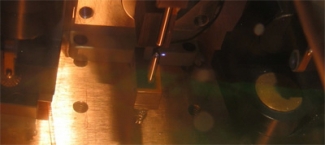Three years ago Jun Ye decided to apply an old idea for amplifying and stabilizing continuous-wave (cw) lasers to state-of-the-art ultrafast lasers. In 2002, Jason Jones, a postdoctoral fellow with Jun, analyzed whether the build-up cavities used to amplify cw laser outputs could be modified to work with ultrafast, mode-locked lasers. His detailed calculations suggested that it would be possible but technically demanding.
A year later, Jason, Jun, and their collaborators at Harvard proved the idea in the laboratory, passively amplifying picosecond (10-12 second) pulse energies by more than 30-fold. By 2004, the JILA researchers were amplifying femtosecond (10-15 second) pulses by more than 70-fold - outside the cavity. Inside the cavity, pulse energies were being enhanced 1000-fold, while continuing to maintain the high quality of the original laser pulses. The researchers realized that the combination of ultrafast lasers and high-finesse cavities should make it possible to generate coherent, high-repetition frequency light in the extreme ultraviolet (EUV) wavelengths. Their method is not only simpler and less expensive to implement than current technologies but will likely be the first to use femtosecond lasers and frequency combs to coherently control electromagnetic radiation in the EUV wavelengths.
The secret ingredient in creating the new high-finesse cavity is custom-designed mirrors. The high-broadband mirrors are not only highly reflective (and low loss), but also prepared specially to control dispersion. The JILA team, now including Mike Thorpe and Kevin Moll, developed the techniques to characterize the new mirrors and worked closely with Advanced Thin Films, the company who built the mirrors as close as possible to JILA specifications.
"Over time, we've gotten better and better results from the folks at Advanced Thin Films," Jason says. "They have been able to improve their manufacturing process based on our measurements. At the same time, we've come to understand what they can and cannot do."
The newest mirrors will make it possible to produce high peak intensities inside the cavity to ionize such noble gases as xenon, krypton, and argon. The longer the cavity mirrors can keep the light pulses circling through these ionized gas samples without the pulses spreading out and losing their shape, the shorter the light wavelengths that can be generated. So far, the cavity can maintain the high quality of the laser pulses through hundreds of round trips as the pulses increase in intensity.
Jun Ye is excited about the new developments with high-finesse cavities. "Jason, Mike, and Kevin's accomplishments demonstrate the promise of combining the techniques of precision measurement and control with ultrafast laser technology," he says. The work on high-finesse optical cavities is reported in five papers published in Optics Letters and Optics Express between October 2002 and March 2005. - Julie Phillips




